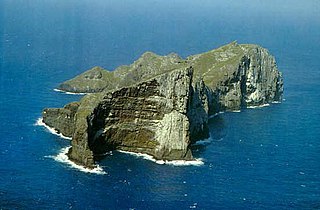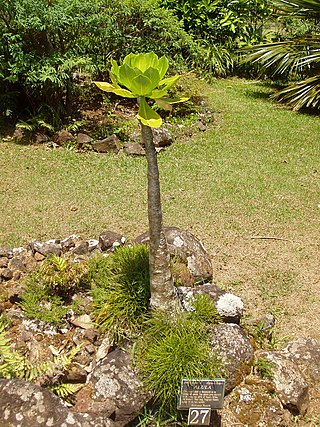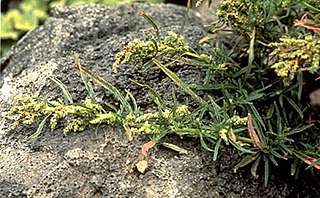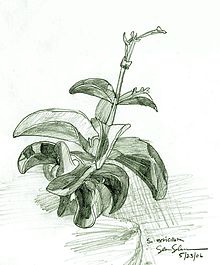
Nihoa, also known as Bird Island or Moku Manu, is the tallest of ten islands and atolls in the uninhabited Northwestern Hawaiian Islands (NWHI). The island is located at the southern end of the NWHI chain, 296 km (160 nmi) southeast of Necker Island. Nihoa is the closest NWHI in proximity to the eight main windward Hawaiian Islands at approximately 240 km (130 nmi) northwest of the island of Kauaʻi. The island has two peaks, 272 m (892 ft) Miller's Peak in the west, and 259 m (850 ft) Tanager Peak in the east. Nihoa's area is about 171 acres (0.69 km2) and is surrounded by a 142,000-acre (57,000 ha) coral reef. Its jagged outline gives the island its name, Nīhoa, which is Hawaiian for "toothed, serrated".

Solanum nelsonii, common names pōpolo and Nelson's horsenettle, is a partially woody sprawling shrub-like perennial plant in the family Solanaceae, part of the Solanum or nightshade genus. This poisonous plant is endemic to the Pacific Islands. It grows low in coastal sites in coral rubble to pure sand.

The Nihoa millerbird is a subspecies of the millerbird. It gets its name from its preferred food, the Miller moth. The 5-inch (13 cm) long millerbird has dark, sepia-colored feathers, white belly, and dark beak. Its natural geographic range is limited to the tiny island of Nihoa in the Northwestern Hawaiian Islands, and it is hoped that birds translocated to Laysan will help to ensure the survival of the species. The Nihoa millerbird is one of the two endemic birds remaining on Nihoa, the other being the Nihoa finch.

Pritchardia remota, the Nihoa pritchardia, Nihoa fan palm, or Loulu, is a species of palm endemic on the island of Nihoa, Hawaiʻi, and later transplanted to the island of Laysan. It is a smaller tree than most other species of Pritchardia, typically reaching only 4–5 metres (13–16 ft) tall and with a trunk diameter of 15 centimetres (5.9 in). It is the only type of tree on the island and used to be abundant. In 1885 a wildfire ravaged the island, destroying most of the palms. Only about 700 of these trees remain, making the species endangered but numbers are slowly increasing. The palm is being cultivated in botanical gardens.

Pritchardia viscosa, the stickybud pritchardia or loʻulu, is an extremely rare endangered species of Pritchardia palm that is endemic to the Hawaiian island of Kauaʻi.

Brighamia insignis, commonly known as ʻŌlulu or Alula in Hawaiian, or colloquially as the vulcan palm or cabbage on a stick, is an endangered species of Hawaiian lobelioid in the bellflower family, Campanulaceae. It is native to the islands of Kauaʻi and Niʻihau. This short-lived perennial species is a member of a unique endemic Hawaiian genus with only one other species.

Amaranthus brownii was an annual herb in the family Amaranthaceae. The plant was found only on the small island of Nihoa in the Northwestern Hawaiian Islands, growing on rocky outcrops at altitudes of 120–215 m (394–705 ft). It was one of nine species of Amaranthus in the Hawaiian Islands, as well as the only endemic Hawaiian species of the genus. It is now considered extinct.
The Nihoa conehead katydid is a species of katydid which is endemic to the Hawaiian island of Nihoa. It is one of the ten species in the genus Banza, all of them native to Hawaii, although it is the sister species to the remaining nine, and may belong in a separate genus. It gets its food mostly from plant leaves, but because of the low population, it does not do significant damage. Unlike Main Islands' species, whose males leap on the females before mating, the Nihoa variants sing to them. It is listed as a vulnerable species on the IUCN Red List, and as a "species of concern" under the Endangered Species Act.

Sesbania tomentosa, commonly known as Oahu riverhemp and ʻōhai, is an endangered species of plant in the pea family, Fabaceae, that is endemic to the main Hawaiian Islands as well as Nihoa and Necker Island. It inhabits low shrublands and, rarely, dry forests, at elevations from sea level to 2,500 ft (760 m). Associated native plant species include akiʻaki, ilima, naupaka kahakai, and pili. Off-road vehicles, wildfires, grazing, and alien species competition have destroyed their habitat on the main islands, but they are still quite common on Nihoa and Necker. At least 2000 specimens grow on Nihoa, while there are far less on Necker.

Schiedea is a genus of flowering plants in the family Caryophyllaceae. It contains 34 species and is endemic to Hawaii.

Kadua coriacea is a rare species of flowering plant in the coffee family known by the common name kioʻele. It is endemic to Hawaii, where it is known only from the island of Hawaiʻi and one individual remaining on Maui. It is a federally listed endangered species of the United States.
Schiedea apokremnos is a rare species of flowering plant in the family Caryophyllaceae known by the common names Kauai schiedea, Na Pali Coast schiedea, and ma`oli`oli. It is endemic to Hawaii, where it is known only from the island of Kauai. It is threatened by the degradation of its habitat. It is a federally listed endangered species of the United States.
Schiedea attenuata is a rare species of flowering plant in the family Caryophyllaceae known by the common name Kalalau schiedea. It is endemic to Hawaii, where it is known only from the Kalalau Valley on the island of Kauai. It is threatened by the degradation of its habitat. It was federally listed as an endangered species of the United States in 2010.
Schiedea helleri is a rare species of flowering plant in the family Caryophyllaceae known by the common names Heller's schiedea and Kaholuamanu schiedea. It is endemic to Hawaii, where it is known only from the island of Kauai. It is threatened by the degradation of its habitat. It was federally listed as an endangered species of the United States in 1996.
Schiedea kauaiensis is a rare species of flowering plant in the family Caryophyllaceae known by the common name Kauai schiedea. It is endemic to Hawaii, where it is known only from the island of Kauai. It is threatened by the degradation and destruction of its habitat. It was federally listed as an endangered species of the United States in 1996.
Schiedea kealiae is a rare species of flowering plant in the family Caryophyllaceae known by the common name Waianae Range schiedea. It is endemic to Hawaii, where it is known only from the Waianae Range on the island of Oahu. It is threatened by the degradation and destruction of its habitat. It was federally listed as an endangered species of the United States in 1996.

Schiedea membranacea is a rare species of flowering plant in the pink family known by the common name papery schiedea and membranous schiedea. It is endemic to Hawaii, where it is known only from the island of Kauai. It is threatened by the degradation and destruction of its habitat. It is a federally listed endangered species of the United States.
Schiedea membranacea is a rare species of flowering plant in the family Caryophyllaceae known by the common name valley schiedea. It is endemic to Hawaii, where it is known only from the island of Oahu. It has been extirpated from Maui and Molokai. Plants in a population known from Kauai are actually members of other species. Thus, the species is now endemic to Oahu. It is threatened by the degradation and destruction of its habitat. It is a federally listed endangered species of the United States.
Schiedea sarmentosa is a rare species of flowering plant in the family Caryophyllaceae known by the common name cliff schiedea. It is endemic to Hawaii, where it is known only from the island of Molokai. It is threatened by the degradation and destruction of its habitat. It is a federally listed endangered species of the United States.

The Northwestern Hawaii scrub is a tropical and subtropical grasslands, savannas, and shrublands ecoregion on the Northwestern Hawaiian Islands in the Pacific Ocean.













